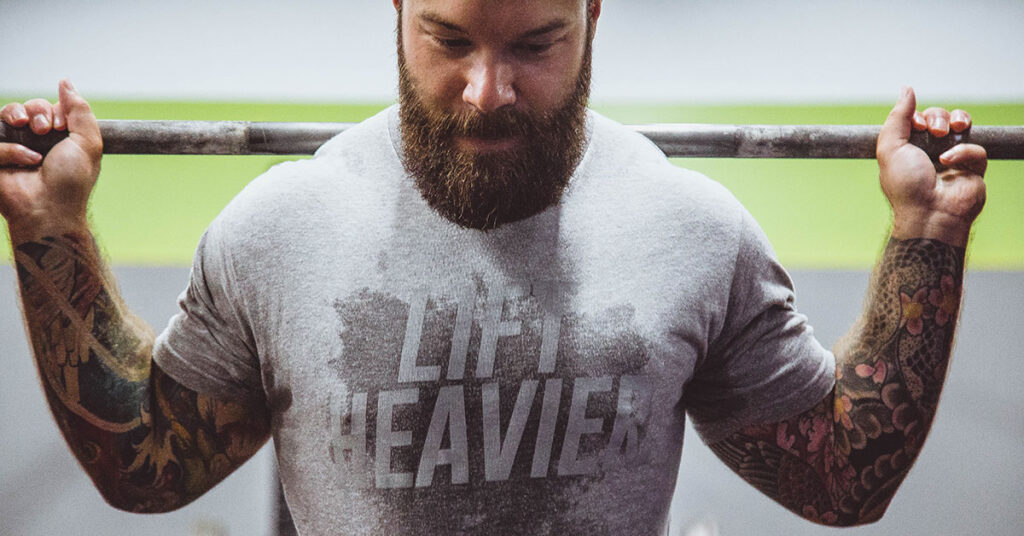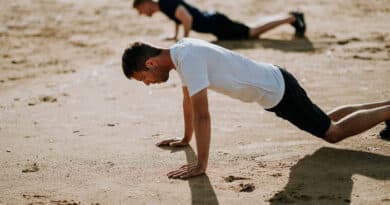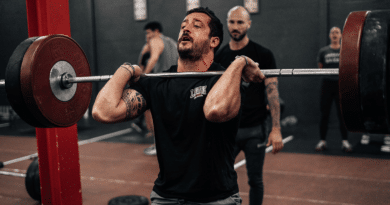
Good Mornings Workouts, Benefits, Muscles Worked and Technique Tips
Good Mornings are among the most fundamental lower back, hamstring, and glute accessory exercises done by powerlifters, Olympic weightlifters, Strongman, and fitness athletes.
What Muscles does the Good Morning Exercise Work?
The Good Morning exercise works the following muscles:
- Gluteals
- Hamstrings
- Spinal Erectors
- Upper Back
- Scapular Stabilizers
Benefits of the Good Mornings Exercise
There are many benefits of the Good Mornings Exercise including, but not limited to, the following:
Lower Back Health
The Good Morning is an accessory exercise that strengthens and develops the spinal erectors, glutes, and hamstrings.
Movements like back squats (low and high bar), deadlifts, and weightlifting movements all require a lifter to establish spinal stability and resistance against lumbar flexion.
Increasing isometric strength of the spinal erectors while also enhancing the overall strength of the glutes and hamstrings can help lifters who may find themselves in compromised deadlifting positions (too far over the bar) or leaning too forward in the squat (bar passing midfoot).
Note, that both faults should be addressed via technique modifications, however having a stronger lower back and hips can aid in performance and injury resilience in the event an athlete does find themselves in a compromised position.
Glute and Hamstring Development
As discussed above, the Good Morning can be used to increase hamstring and glute hypertrophy and control.
Good Mornings find their way in most powerlifting and weightlifting program since the competitive lifts require a lifter to be in a bent over position (deadlifts, squats, and Olympic lifts) under load.
The purpose of this exercise is to not only increase hamstring and glute strength and muscle hypertrophy, but also help the lifter establish better movement patterning in their competitive and training lifts.
Upper Back Strength for Deadlifts and Squats
When performing squats and deadlifts (as well as other strength and power movements), resistance to spinal flexion (specifically lumbar) is key to injury resilience and bar patterning/load distributions.
Exercises like the Good Morning can be used to increase a lifter’s strength and awareness of the lower and upper back for the above movements.
Enhancing upper back tension and lower back stability can help lifters who lack the strength to pack the barbell tightly in the back rack and/or tend to fall forward in the squat and cannot recover from poor positioning.
Note, the good morning can be used to aid proper technique and patterning in deadlifts and squats, however should not be the only solution in the event squat/deadlift/pulling technique and mobility is insufficient.
How do you Perform Good Mornings?
Step 1: Set up similar to a Back Squat with a stance between hip- and shoulder-width.
Place the bar across your back in the high- or low-bar position.
Grip the bar tightly, pull the bar into your body, take a deep breath in and tighten your core.
Step 2: Break at your hips to initiate the movement.
Continue pushing your hips back until your torso is at about 15 degrees above parallel.
Your shins should remain vertical and your knees should be slightly bent at the bottom of the movement.
Step 3: Push your hips forward to drive up to the starting position.
Exhale at the top of the movement.
Good Morning Technique Tips
First and foremost, you must learn how to set up for a Squat, engage your back and tighten your core. You can find detailed instructions on how to do that here.
Use a low-bar position across your rear delts because it makes the exercise a bit safer. That said, the high-bar position across your traps is also fine—it works the hamstrings and lower-back muscles a bit more.
One of the worst mistakes is trying to go to parallel or even lower. Instead, stop at about 15 degrees above parallel.
Start with a weight that’s about 25 percent of your Back Squat and work to lift 50 percent of your Back Squat.
Do not try the straight-leg version of the Good Morning if you are a beginner. The bar travels too far forward and places a ton of stress on your lower back.
3 Good Mornings Workouts
Add these Good Mornings Workouts into your training.
WORKOUT 1
3 Rounds for Total Reps in 18 minutes
- 1 minute Max Mountain Climbers
- 30 second Rest
- 1 minute Max Rucksack Good Mornings (30/20 lb)
- 30 second Rest
- 1 minute Run
- 30 second Rest
- 1 minute Rucksack Push-Ups (30/20 lb)
- 30 second Rest
One full round will consist of 4 total minutes of work, with 30 seconds of rest between minutes.
One full round will take 6 minutes. So, this workout should take a total of 18 minutes.
Given the built-in reps, athletes should hit each minute of work with full intensity.
Score is the total number of repetitions completed before the 18-minute clock stops. However, the original post mentioned there will be no measure for this workout.
WORKOUT 2
For Time
- 100 Alternating Lunges
- 100 Air Squats
- 100 Alternating Reverse Lunges
- 100 Good Mornings
Every 2 minutes on the minute, perform:
- 10 Floor Presses (pick object & load)
With a running clock, as fast as possible complete 100 reps each of Alternating Lunges, Air Squats, Alternating Reverse Lunges, and Good Mornings. Every 2 minutes, perform 10 Floor Presses before proceeding where you left off.
Score is the time on the clock when the 100th Good Morning is completed.
Movement Standards
Floor Press: This movement is a variation of the standard Strict Press. Lay on the ground with heels close to the hips and knees perpendicular to the floor.
Hold the chosen object by your chest and press up away from the chest. Make sure the elbows are fully extended forward before lowering the object towards the chest. This is one rep.
WORKOUT 3
7 rounds
- 7 floor press + leg raise
- 7 barbell push ups
- 7 bent over row
- 7 hang power clean
- 7 shoulder press
- 7 good mornings
- 7 back squat
*perform all movements with same barbell
Good Mornings FAQs
Got more questions about Good Mornings? Check out our FAQs
Are Good Mornings Bad for your Back?
No. The Good Morning exercise gets a bad rap; however, the Good Morning is one of the best exercises to develop your glutes, hamstrings and lower-back muscles – when done correctly.
If you find yourself stuck on your Deadlift and Squat, it could be the key to blasting through a plateau.
How much Weight Should I Use for Good Mornings?
Good mornings target your entire posterior chain—especially your hamstrings and lower back. As a result, you should start light and build up gradually. Do not try to max out this exercise.
Reps/sets for best warm up results: Aim for 12 to 15 reps with a 5 to 10 pound weight for a sure-fire way to get the hamstrings, glutes, and lower back ready for heavier lifts like deadlifts and squats.
What Can I do Instead of Good Mornings?
The following six are all excellent Good Morning Exercise Alternatives:
- Back Extension Variations
- Reverse Hyperextensions
- Hip Thrusts
- Glute-Ham Raises
- Resistance Band Good Morning
- Reverse Chinese Plank
What’s the Difference Between Good Mornings and Deadlifts?
Good mornings use a hinge motion at the hips whereas deadlifts use an up and down motion. Good mornings isolate your hamstrings and glutes.
They also utilise your lower back and core. Deadlifts target more muscles throughout your entire body with the most emphasis placed on the lower body (quadriceps, glutes and hamstrings).
Why are Good Mornings Called Good Mornings?
It is known as a good morning because of the movement in the erector spinae which resembles the rise out of bed to stretch.
The erector spinae muscles of the lower back work isometrically to keep the spine in an extended position while the hamstrings and gluteus maximus work isotonically to perform hip extension.
Are Good Mornings Push or Pull?
Good Mornings are a pull exercise. Examples of hip extension lower-body pulling exercises include deadlifts, reverse hyperextensions, good-mornings and pull-throughs.
Are Good Mornings Dangerous?
Good Mornings done properly are one of the best posterior chain exercises. But when they’re performed improperly, with more weight than the lifter can handle, then they can become a dangerous exercise.
You’re most at risk for an injury at the bottom of a rep when your torso is closest to parallel. That is why great form is so important.
Good Mornings Exercise Variations
To add more variety into your training program, try these Good Mornings Exercise variations.
SEATED GOOD MORNINGS
The Good Morning can also be done from a seated position to isolate the spinal erectors and minimize hamstring tension.
This obviously will decrease the amount of loading one can do when compared to the standing good morning.
SINGLE LEG GOOD MORNINGS
The single leg morning is one of the most brutal hip hinge movements in existence as the level of tension to the glutes, hamstrings, and lower body stabilizers is difficult to replicate with any other movement.
It also tends to be easier on the lower back because you’re handling lighter loads and because the back leg acts a counterweight to reduce anterior shearing forces and torque on the spine.
ZERCHER GOOD MORNINGS
The Zercher good morning is another variation that is more lower back friendly than the traditional back loaded variation. This is because the weight is positioned closer to the centre of mass.
DRAPING CHAIN METHOD
The draping chain technique adds an additional instability component. This forces the lifter to control the load and stabilize to a greater degree, essentially making them perform the movement in a more controlled fashion.
HANGING BAND TECHNIQUE
If you’re looking for a protocol that forces the lifter to clean up their form and master the good morning exercise with high levels of motor control, the Hanging Band Technique as shown by football athlete Ike Onike can’t be beat.
The unpredictable oscillations produce increased muscle activation, motor unit recruitment, proprioception, and intramuscular tension.
All of which help the lifter take their mechanics and muscular development to the next level.
SAFETY BAR GOOD MORNINGS
Similar to barbell back squats, many lifters struggle with shoulder mobility as the back loaded position can place significant strain on the glenohumeral joint. The safety bar Good Morning is a good compromise.
CAMBERED TRAP BAR GOOD MORNINGS
The cambered trap bar protocol is very conducive for applying to good mornings as the hanging nature of the trap bar makes the movement feel more natural than traditional good mornings.
It’s significantly less stressful on the spine while still being effective for torching the glutes and hamstrings.
As an added bonus it’s also quite shoulder friendly.
TOES ELEVATED DORSIFLEXION GOOD MORNING
A simple yet effective modification for increasing the stretch and stress to the posterior chain while also helping to reinforce the idea of sitting back into the hips is simply elevating the toes on small plates.
This creates a more dorsiflexed ankle position which produces a greater stretch to the glutes and hamstrings.
If you have trouble feeling your posterior chain work, this one will do the trick.
GOBLET GOOD MORNING
If you’re looking for a good morning variation that reduces stress to the low back and spine while still pummels the entire posterior chain, look no further than the front loaded variations such as this goblet version.
FRONT CURLED DUMBBELL GOOD MORNINGS
Similar to the goblet version, the front curled variation provides a similar benefit.
However, these provide an added bonus of crushing the biceps as you’ll be using every bit of strength to keep the arms from extending towards the ground.
These also place the shoulders in a more neutral and less crowded position than the goblet variation making it easier to lock the shoulders and upper back into their appropriate position.
Just be warned, it doesn’t take a significant amount of weight to feel these as even 20 pound dumbbells will provide an intense stimulus for most athletes.
BULGARIAN GOBLET GOOD MORNING
The Bulgarian goblet good morning is one of the more deceptively challenging yet effective posterior chain exercises that simultaneously improves hip mobility and lower body stability.
The split stance position, combined with the anterior loading, also makes it lower back friendly.
Just be prepared for a serious burn in your glutes and hamstrings, not to mention your core and abs.
SINGLE LEG GOBLET GOOD MORNING
Once you’ve mastered the bilateral goblet good-mornings, try progressing to single leg versions.
Combining these with contralateral knee drive also makes them quite conducive for improving sprint performance and stride mechanics.
The elevated back leg also acts as a counterweight to help reduce anterior shearing forces and torque on the spine.
In fact, once you master your stability and balance you may find you end up using similar weights with the unilateral version as you would the bilateral due to the counterbalancing effect of the back leg.
As a result, the glutes and hamstrings get absolutely attacked.
BOTTOMS UP GOOD MORNING
Learning to keep your whole body as tight as possible is critical on all movements, particularly ones that involve axial loading such as the good morning.
The bottoms up kettlebell good morning is one of the most effective variations there is for teaching the athlete to maintain maximal intramuscular tension, spinal rigidity, and full body tension throughout the good morning exercise.
That’s because bottoms up movements help increase core stabilisation and grip activation which has been shown to produce concurrent activation potentiation and irradiation.
In other words, it teaches you to stay tight from head to toe thereby increasing neural drive and recruitment to the working extremities.
Be ready to brace every muscle fibre in your being on these as the level of intensity is through the roof.
As an added bonus these are a brutal grip, forearm, and shoulder stabiliser exercise as the upper body will be working overtime to keep the kettlebells from collapsing.
BOTTOMS UP SINGLE LEG GOOD MORNING
The bottoms up good-morning is an incredible hip hinge variation.
Unfortunately grip and arm strength is oftentimes the limiting factor as the upper body can fatigue before the glutes and hamstrings.
By performing these in a single leg fashion you reap the benefits associated with bottoms up loading while also ensuring substantial unilateral overload to each hip.
Good Mornings Workouts
If you found these Good Mornings Workouts, tips and variations useful then check out these Lunge, Goblet or Back Squat Workouts.




Comments are closed.